By Nicole Di Tomasso
The key to achieving the perfect pizza lies not just in its ingredients, but in the oven used to bake it. Whether it’s the traditional charm of a wood-fired oven or the high-tech efficiency of a conveyor oven, each type allows restaurateurs to tailor their pizza offerings to their unique style and customer preferences.
Neapolitan pizza, which emerged in Naples, Italy in the 19th century, is intrinsically linked to wood-fired ovens. These ovens, known for their distinctive dome shape, are designed to reach temperatures as high as 900 degrees Celsius, ensuring a blistered crust with a slightly charred flavour in approximately 90 seconds.
Drawing inspiration from the Neapolitan pizza tradition, Pizzeria Libretto opened its Ossington location in 2008 and became one of the first restaurants in Toronto to serve VPN (Vera Pizza Napoletana) certified pizza within the strict guidelines laid out by the Napoli government. Today, Pizzeria Libretto operates four locations around Toronto, including Ossington, Yonge and Sheppard, Danforth and University.
Gas pizza ovens are a modern alternative to wood-fired ovens, providing the ability to control temperature more precisely. These ovens can reach high temperatures but with less effort in managing the heat source.
“When we first opened, a lot of customers said the pizza was burned or too soft, but a Neapolitan pizza is supposed to have a blistered look with a soft centre,” says Rocco Agostino, executive chef and partner, Pizzeria Libretto. “If you’re looking for something crispy, a Neapolitan-style pizza isn’t going to give you that.”
Currently, the Danforth location has one wood-fired oven and one hybrid (wood-gas mix) oven from Italy-based company Stefano Ferrara Forni; the Ossington location has one hybrid oven from Stefano Ferrara Forni (its original wood-fired oven had to be replaced after 15 years of service); the University location has two hybrid ovens from Stefano Ferrara Forni; and the Yonge and Sheppard location has one rotating pizza oven from Maryland-based Marra Forni.
The Stefano Ferrara Classico Pizza Oven, which is available in five sizes (110 to 150cm), features a crown and dome made from refractory bricks, with a temperature resistance over 900 degrees Celsius. Mosaic tiles of palladiana marble make up the exterior covering.
Agostino says the ovens range between $30,000 and $50,000 depending on the oven and shipping costs, adding the group of restaurants use the 140cm model.
“The openings of the Neapolitan pizza ovens are smaller than typical ovens, which helps retain the heat better,” continues Agostino. “The Marra Forni rotating pizza oven is a bit different. We like the simplicity of it. With one or two rotations, the pizza is cooked perfectly without having to touch it.”
During COVID, Pizzeria Libretto also purchased deck ovens from Italy-based Moretti Forni to offer its New-York style pizzas, which Agostino says are baked at a lower temperature for approximately eight minutes. “The New-York style pizza has thin, golden-brown crust and holds ingredients a little better,” he says.
Overall, Agostino says customers prefer the Neapolitan-style pizza over the New-York style, with the Margherita pizza as the top seller. On a busy day, Agostino says one restaurant location will serve about 400 pizzas.
Custom Cooking
Washington-based Wood Stone Corporation manufactures wood-fired, stone-hearth and gas commercial pizza ovens. The stone-hearth ovens offered include the Bistro Line, Mountain Series, Fire Deck + FA 9660 and Traditional Series.
“The Fire Decks are workhorses,” says Dean Tryon, director of Innovation and Engineering, Wood Stone Corporation. “They’re ideal for high-volume, big production facilities. The Mountain Series has volume but it’s more customizable for a restaurant’s needs. Bistro is a smaller, scaled-down version of all those for a smaller footprint.”
Wood Stone also manufactures the OneRev rotating pizza oven. “The OneRev is unique to the restaurant industry because it can cook a pizza perfect every time with one rotation. Operators will get a consistent bake and it eliminates the need for a trained oven operator,” says Tryon. “With the non-rotating hearth ovens, operators can get the same quality but someone needs to operate the oven, spin the pizzas, get them in and out and monitor the bake quality.”
While the hearth ovens are solid fuel or gas, the OneRev oven is gas. “The biggest selling feature [of the OneRev] is that the person building the pizza can now put it in the oven and pull it out, so operators can technically eliminate a role in their operation,” says Tryon.
“Operators can customize the OneRev oven to their dough recipe,” he continues. “They can set the speed of the oven, as well as the top heat and the bottom heat for their dough. If an operator is baking a small pizza that’s lightly topped and a large pizza that’s heavily topped, the time is exactly the same because it uses a unique reactive cooking surface instead of storing energy and cooking with what’s in the hearth oven.”
The OneRev can cook any pizza between 90 seconds and six minutes, says Tryon, adding that operators can simply sweep off debris to clean and run the oven hotter to remove stains. The oven is also belt-driven, making any necessary repairs quick and easy.
“Hearth ovens cook more than just pizza. Anything you can cook in an oven can be done in a hearth oven as well,” says Tryon. “However, OneRev was specifically designed for pizza. For operators specializing in deep dish or pan pizza, it would be easier to cook those in the hearth oven rather than the OneRev.”
OVEN EVOLUTION
The evolution of commercial pizza ovens has been significantly influenced by technological advancements.
Using technology made popular in France by ADIAL, automated pizzeria PizzaForno has built its brand on a proven food-tech platform with more than 2,800 operating in Europe.
“We found the technology about five years ago and brought it to Canada,” says Les Tomlin, co-founder and president, PizzaForno. “As we started to expand our distribution in North America to the U.S., ADIAL opened an assembly facility in Waterloo, Ont.”
Tomlin continues, “Our pizzas are all mass produced at a central commissary [just outside of Chicago] and then flash frozen. Then they’re shipped to each one of our franchisees or licensees across Canada, the U.S. and Mexico. The frozen pizzas are then put into a pizza box and inserted into the machine and goes through a defrost cycle to bring it to refrigerated temperature. After it’s defrosted for two to three hours and a customer orders it, it gets transferred into the dual convection oven [by a robotic arm].”
“The convection oven is critical because it bakes the toppings and bakes the last 20 per cent of the crust, which already comes par-baked,” says Tomlin. “That allows us to bake any of our pizzas in less than three minutes. It’s not soggy and comes out as it crispy as it would out of a traditional pizzeria’s stone oven or wood-fired oven.”
Each unit can hold 70 pizzas, which are baked one at a time at 420 degrees Celsius. The unit offers six different pizzas, including Pepperoni, BBQ Chicken, Four Cheese Blend, Hawaiian, Meat Lovers and Vegetarian, however, Tomlin says the company is always working on new varieties and limited-time offers to keep things fresh. Its recently introduced Breakfast Pizza, for example, is topped with scrambled eggs, bacon, ham and red pepper.
PizzaForno recently expanded into Manitoba and currently has more than 70 operating locations and more than 100 additional locations committed in the U.S. alone, with the first 15 U.S. locations already established in California, Georgia, Michigan, Texas and Louisiana.
“The joy of the machine is it’s robotic, which makes it sound complicated but it’s actually quite simple,” says Tomlin. “It has a 99 per cent uptime rate,” adding that the technology can detect if the machine breaks down mid-cycle and will automatically refund or not charge the customer.
The world of commercial pizza ovens is vast and varied, with each type offering unique benefits suited to different styles of pizza and business models. As technology continues to evolve, the future of commercial pizza ovens looks promising.


















